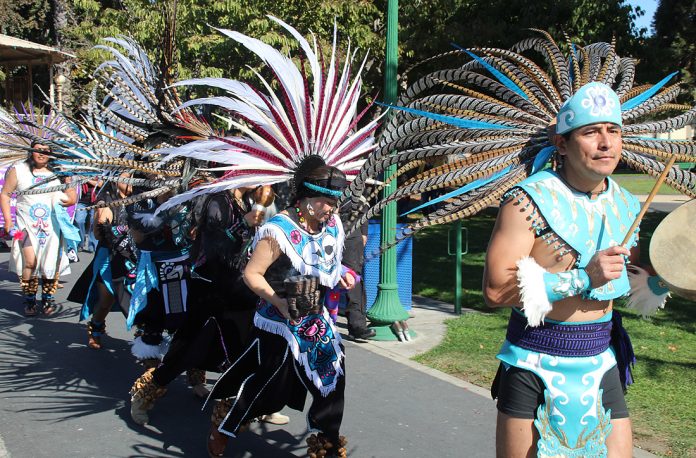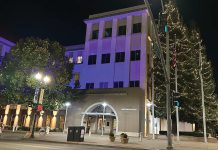
WATSONVILLE—Paul De Worken left the Watsonville City Council Chambers sad and confused on Oct. 22. A few days later he was in a better mood, but his confusion did not fade.
After the City Council approved a $200 fee for community initiated public art on privately owned commercial spaces, an editorial from Mayor Francisco Estrada said the City would allocate $4,000 to help offset the fee.
“It was a lot in a few days,” De Worken said. “One day they say they don’t have money and then another day they have $4,000… More than anything, I was confused.”
De Worken and roughly a dozen other artists spoke during the meeting in hopes that the Council would nix the fee, which they believed would be yet another barrier for young artists to find their niche and established artists to expand.
Instead, the Council voted 4-3 to approve the fee—Estrada, Mayor Pro-Tem Rebecca Garcia and councilman Felipe Hernandez voted no—and they received what local artist Jessica Carrasco called an unexpected “scolding” from council members who said they weren’t doing enough.
“After the meeting, we were all pretty devastated,” Carrasco said. “Not only did we not get what we wanted and what the community was asking for, but we were also told we’re not doing enough—that we need to work harder…We don’t agree with that. We are working hard, and we wish we had more support.”
MOUNTING FEES
About a year and a half ago Carrasco had the idea of bringing together local artists to one booth at the annual Strawberry Festival. She was able to get multiple artists from different mediums—paintings, stickers, clothing, jewelry—to buy into the project and presented the idea to the festival’s organizers.
“I thought it would be good to showcase the talent we have here in our hometown,” said Carrasco, whose art brand, Carrasco Concepts, sells Watsonville-themed stickers to raise money for three different scholarships that benefit local college students.
She said the idea was swiftly rejected but found new life when Estrada heard of the concept. Estrada worked with fellow councilman Aurelio Gonzalez, who asked if Pajaro Valley Arts (PVA) could use its nonprofit status to sponsor the booth. PVA obliged but festival organizers still charged the typical $600 fee for a nonprofit booth.
Carrasco said the artists were willing to pay the fee for the three-day festival but Nordic Naturals instead covered their bill with a last-second donation.
Carrasco said $600 might not seem like much, but for many local artists—most of who work full-time jobs on top of their art projects—that money is potentially backbreaking.
“It was a year and a half of hard work and the entire time I was saying, ‘man, there’s no love here.’ Even if you’re doing things for the greater good,” said Carrasco, a social studies teacher at Lakeview Middle School. “I don’t make money off my art. All of it goes toward the youth. I do it because I love Watsonville—all of us do—and I think that’s what the City isn’t seeing.”
Gabe Medina, a local visual and performing artist, said that is just one instance of the Parks and Community Services (PCS) Department’s recent wave of fees and unwillingness to work with local artists.
The White Hawk Indian Council For Children—a nonprofit group that teaches local young people indigenous dance and ideals at no cost—was recently displaced from the Veterans Memorial Building, the venue in which it operated in for free for more than a decade, because the City started charging for its use. The group now practices at the Springfield Grange closer to Las Lomas.
“This is happening more and more,” Medina said. “Local artists—artists that grew up here and want to make their hometown special—aren’t being given that opportunity.”
Ivan Hernandez, the lead organizer for the White Hawks, said that fee came as a “disheartening” surprise to the nonprofit. He also said the City this year did not waive the fee for the use of the City Plaza for the organization’s annual Xilonen, a coming-of-age ceremony for young women, as it has in the past. As a result, the usual two-day event was trimmed to one day at Pinto Lake County Park.
“People think we’re just teaching people to dance, but for us it’s more,” Hernandez said. “It’s our culture, and we’re trying to share it with everyone in our community. We want to spread the art.”
PCS Director Nick Calubaquib said those fees and the newly-approved art fee are necessary for the department to stay fiscally solvent, and that the department has been more than accommodating to local artists. With the White Hawks, for example, the department allowed the organization to use the Vets Building for only $5.75 per hour, a fraction of the City’s regular rate of $50 per hour.
Calubaquib said the City has also made multiple efforts to support the arts such as bringing concerts to the City Plaza and the Henry J. Mello Center, which is now under its management in association with the Pajaro Valley Unified School District.
“We’re in a tough spot because there’s not enough funding for all this,” Calubaquib said. “It’s been a balance. How can we be accommodating and still have the money to keep the lights on? We’re trying to support as many things as we can, but the money isn’t there right now.”
GIVE AND TAKE
The $4,000 mentioned in Estrada’s editorial was pulled from the City’s Social and Community Service Grants, a yearly allotment for nonprofit organizations that serve the community. More specifically, it was taken from the Special Events Sponsorships portion of the program, which helps yearly events not organized by the City run smoothly by paying for various costs.
According to Calubaquib, after the $4,000 disbursement, there is only $500 left for the rest of the 2019-20 fiscal year, which runs until June. He said his department has already set aside funds for most of the large events such as Cinco De Mayo, but smaller events will have to look elsewhere for help.
“That’s what we want to stress: this money didn’t come out of the air,” Calubaquib said. “That money is coming from a cut somewhere else, which is tough.”
Exactly how that money will be spent and who will have the authority to say what public art will receive monetary help has yet to be determined, Calubaquib said. There is also no guarantee the $4,000 will be doled out next fiscal year.
Calubaquib expected to have a solidified plan for the funds in a few weeks.
That, Carrasco said, has the local art community worried that it will once again be left out of a process in which it could be a strong ally.
“The last few weeks have been a rollercoaster and I just have a lot of questions,” Carrasco said.
De Worken said that was his main issue with Phase I of the Public Art Program, which set guidelines for public art on privately owned businesses: There was little time for the artist community to give input that could have been useful.
“I still stand by what I said,” he said. “I thought the guidelines and fees were rushed the first time they were presented, and I think everything that’s happening now is because of that.”
FUTURE PLANS
Next year the Council will hear Phase II of the Public Art Program, which will determine how the City will treat public art projects that it fully or partially funds.
Though many of the details of that phase are still fuzzy, Watsonville City Manager Matt Huffaker said staff is looking at different funding streams, including a “percentage for the arts” method which would collect a percentage of the cost of construction projects throughout the city.
Medina and Co. also have plans for the coming months. He said local artists have started meeting every month to talk about the issues facing the community and inform one another of funding opportunities. They are also thinking of creating an arts commission, which would better advocate for the community.
“Right now it’s very reactive. The city says something and we react,” Medina said. “Most of the time it’s too late. They already have their minds made up on things before they hear the public…We want to be proactive, and right now I don’t see any other way to do that.”











